Conklin All American Sacless Vacuum Pen c1937
by Jim Mamoulides, February 5, 2010
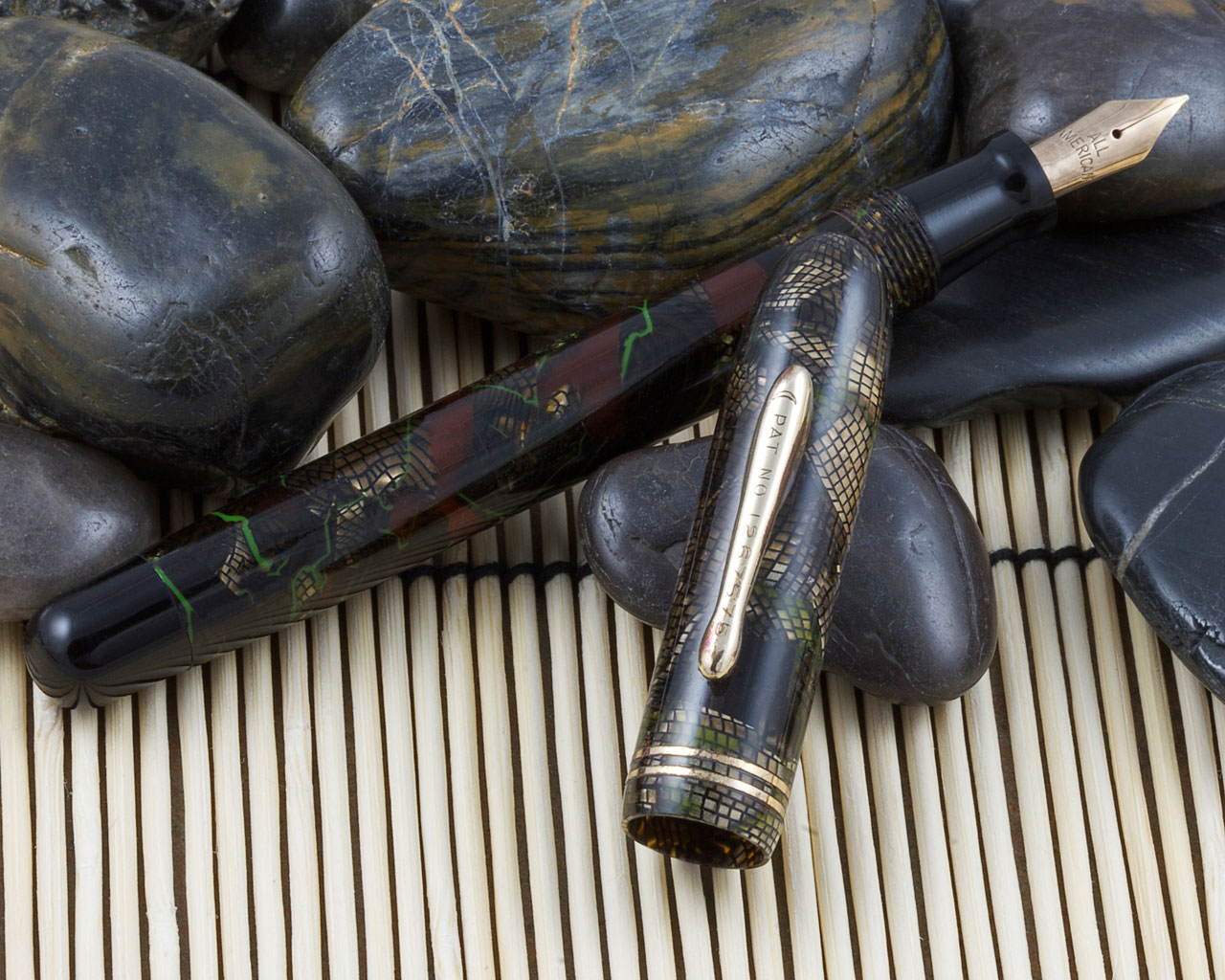 Conklin All American Sacless Vacuum Pen in Reptilian Gold-Green Vein c1937
Conklin All American Sacless Vacuum Pen in Reptilian Gold-Green Vein c1937
A Conklin All American
By the 1930s, Conklin, once the leader in self-filling fountain pens with its Crescent Fill pens, introduced in 1898, had fallen behind Parker, Waterman, Sheaffer and Wahl Eversharp. The company stuck to the cash cow Crescent Filling system well into the 1920s, not offering a more modern lever-fill type pen until 1923, and continued to offer Crescent Fill models through the 1926 catalog. In a move that was probably too late to revive sales, Conklin introduced the piston-filling Nozac pen in 1932, the first sacless pen offered by a major manufacturer.
The 1930s must have been lean times for Conklin, as the company could not match the heavy advertising of its big four rivals, who could blanket the primary medium, magazines, with full page and often full color advertisements. Eventually, in 1938, the company was sold to a Chicago syndicate, and the pens that followed were cheaper, basic models that never matched the design and innovation of the previous forty years.
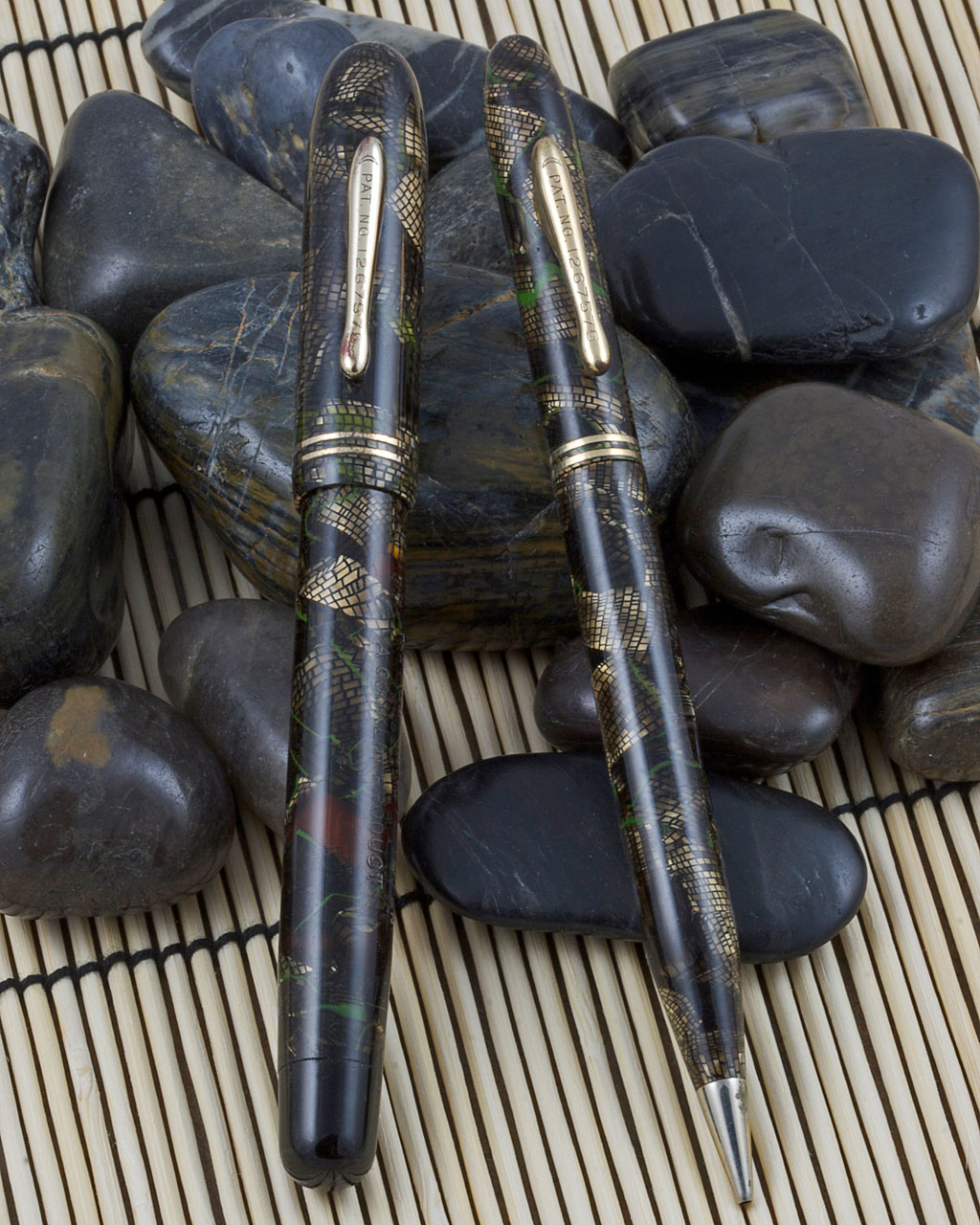 Conklin All American Sacless Vacuum Pen in Reptilian Gold-Green Vein with matching pencil c1937
Conklin All American Sacless Vacuum Pen in Reptilian Gold-Green Vein with matching pencil c1937
Conklin offered a budget second line, called "All American," in the 1930 catalog. Major pen companies always had lower priced pens, but this line was really aimed at the budget market, considering the dawn of the Depression. The first All American pens were plain flat-top models in amber, plain black, blue and green, and were sold in lots of a dozen, in a mix of full size, short size, and ringtop pens. By the 1937 catalog, where this pen set appears, the All American line was essentially a downgraded version of the standard pen line. Because of lack of primary information, I don't know if these pens were offered more than the one year, 1937. They definitely are not common.
Although aimed at the moderate price market, the fit and finish of the Conklin All American Sacless Vacuum Pen matches the higher line Conklin products. The snakeskin celluloid on these pens is prized by collectors and came in three colors, Reptilian Pearl-Gray, Reptilian Gold-Green Vein, and Reptilian Foliage-Red Vein. The material on the Conklin All American Sacless Vacuum Pen had large clear patches in the pattern on the barrel, allowing the user to check the ink supply. In the 1937 dealer brochure, the fountain pens were offered for $2.95 and the matching pencils were $1.00. Conklin also made All American Sac Pens, lever fill versions of the same pens, that were offered for $1.95.
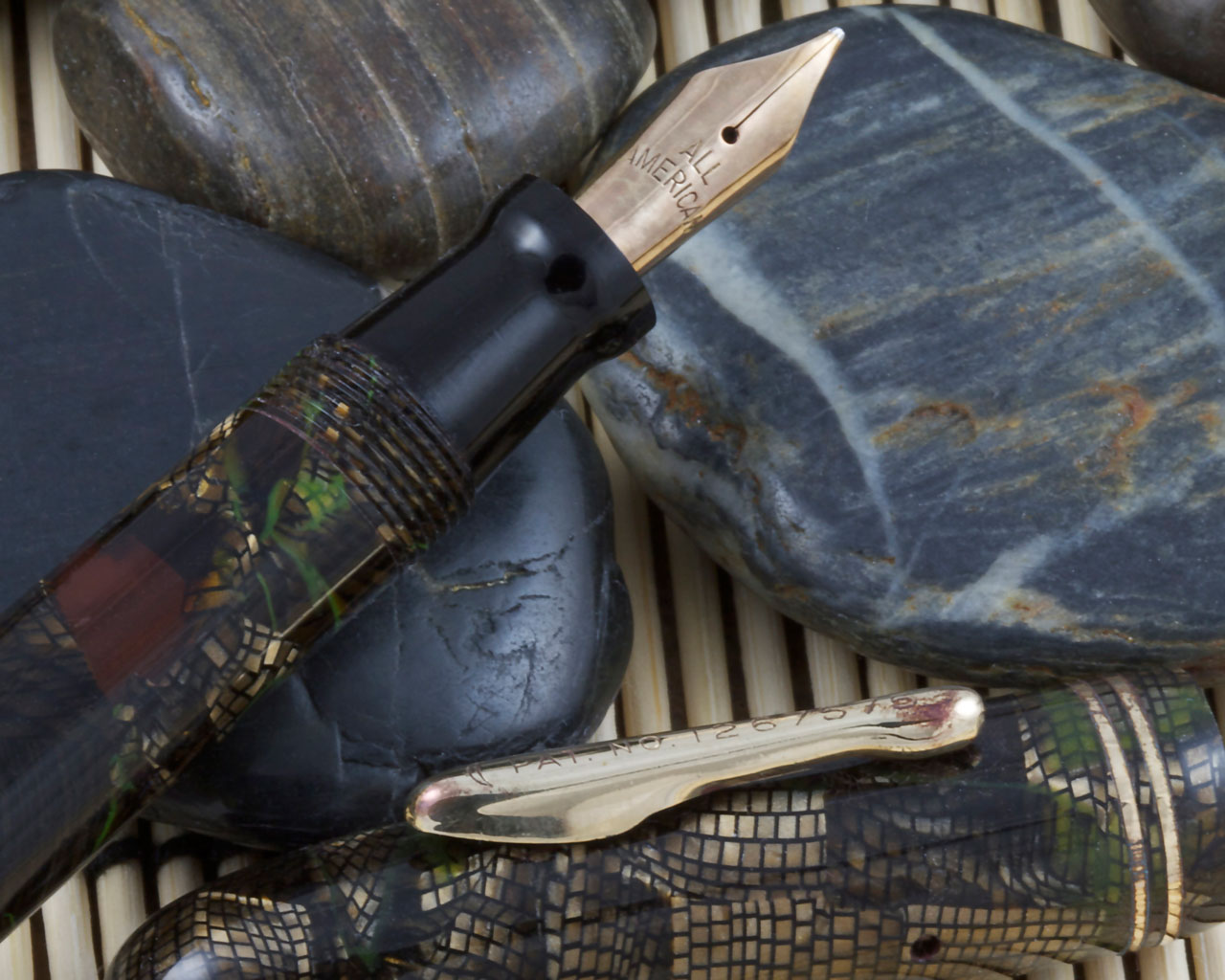 Conklin All American Sacless Vacuum Pen in Reptilian Gold-Green Vein c1937 cap and nib detail
Conklin All American Sacless Vacuum Pen in Reptilian Gold-Green Vein c1937 cap and nib detail
The filling mechanism in the Conklin All American Sacless Vacuum Pen is really no different than the one used on the Conklin Quick-Fill, except the Quick-Fill pen integrates the blind cap with the plunger, as on Sheaffer's Vacuum-Fill pens. The All American has the same patented spring loaded rocker clip with the Conklin Crescent logo at the top, as found on the all top end Conklin pens. The basic design of this clip, patented on May 28, 1918, had been part of the Conklin look for twenty years. The major differences between this pen and the higher models are the nib and the barrel stamping. The gold nibs on these pens are not hallmarked, indicating a lower grade of gold alloy, as they are definitely not plated stainless steel. Sheaffer offered low end gold nibs on their WASP line, so Conklin may have done the same. The only marking is simply "ALL AMERICAN." Also unlike Sheaffer, Conklin not only stamped the barrel with the "ALL AMERICAN" sub brand name, but also clearly indicated that the pen was a Conklin product on the line below.
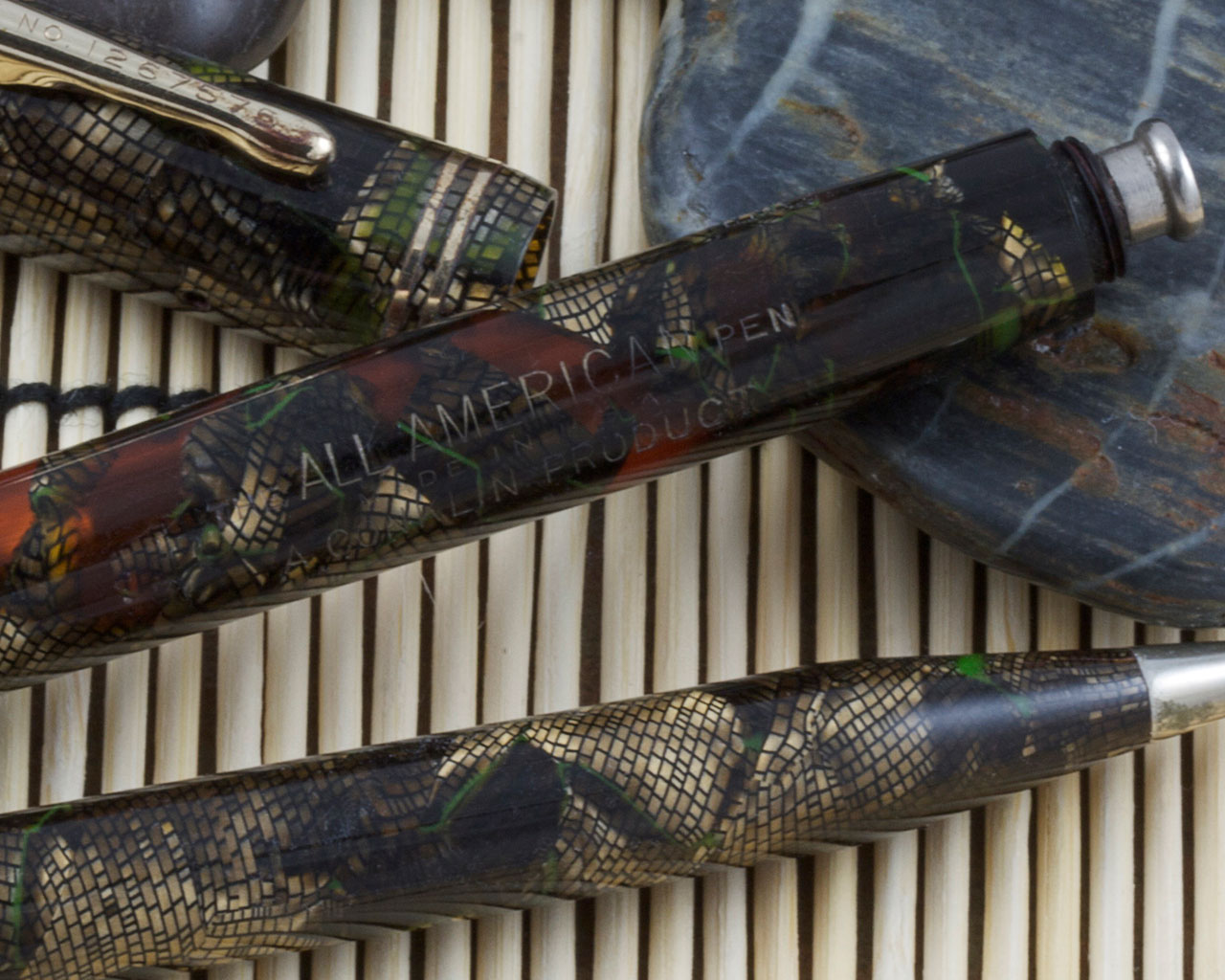 Conklin All American Sacless Vacuum Pen in Reptilian Gold-Green Vein c1937 imprint detail
Conklin All American Sacless Vacuum Pen in Reptilian Gold-Green Vein c1937 imprint detail
The Conklin All American Sacless Vacuum Pen operates like any plunger type vacuum fill pen. Conklin decided to use a plunger rod with a secure metal cap hidden underneath a blind cap, instead of Sheaffer's method of incorporating the cap as the pull for the rod. The pen fills almost completely on a single downstroke, but it's a two handed job. First pull out the plunger rod, then insert the section in the ink bottle, and while holding the pen barrel, quickly push in the rod. The vacuum created by the air being pushed out of the barrel causes ink to rush in when the end of the rod hits the diverter at the base of the feed. All that's left is to wipe the nib and section, put the blind cap back on and start writing.
Identification guide and features:
Conklin offered the American Sacless Vacuum Pen with five nib grades, extra fine, fine, medium, coarse (broad), and stub medium.
- Reptilian Gold-Green Vein plastic cap and barrel
- Barrel pattern has transparent elements to provide visible ink supply
- Barrel imprinted "THE ALL AMERICAN PEN" over "MADE IN U.S.A." over "A CONKLIN PRODUCT"
- Gold plated trim
- Clip stamped with Conklin Crescent logo at top with "PAT. NO. 1267575" down the face
- Ungraded gold nibs offered: extra fine, fine, medium, coarse, stub medium, stub broad, left oblique, two way and Recorder in extra fine, fine, and medium
- Ungraded gold nib stamped "ALL" over "AMERICAN"
- Screw on cap
- About 5 1/8 inches long capped and 5 7/8 inches posted inches long with the cap posted on the end of the barrel
- Weighs 0.6 ounces
- One-stroke vacuum plunger filling system
- Retail price of the one-stroke vacuum plunger filling fountain pen, model P295RG, was $2.95, matching pencil, model 63RG, $1.00, matching sac filling Pointer fountain pen, model 64RG, $1.95
- Presented in a paperboard gift box
Performance
This Conklin All American Sacless Vacuum Pen in Reptilian Gold-Green Vein is a standard size, lighter weight pen, weighing 0.6 ounce and being 5 1/8 inches long with the cap on and 5 11/16 inches with the cap posted on the end of the barrel. I find the feel in the hand better with the cap posted on the end of the barrel, and it is secure enough to where I don't worry about it coming off while writing. It's just too short unposted.
All the original All American nibs I have seen have been quite firm, and this one, a fine, is no exception. It writes smoothly and evenly, but it is not as nice a nib as the better quality Cushon Point nibs used on the Nozac and other higher end Conklin pens. I actually don't find it compelling enough make me to want to write with the pen. I have only filled this pen a few times as the barrel is already ambered enough and I don't want to encourage more darkening. If I want to write with an All American, I usually defer to one of my lever fill version pens instead. I have one of those with a very nice writing 14 karat gold non-original warranted nib that I do use occasionally. I almost feel these pens are better off left unused.
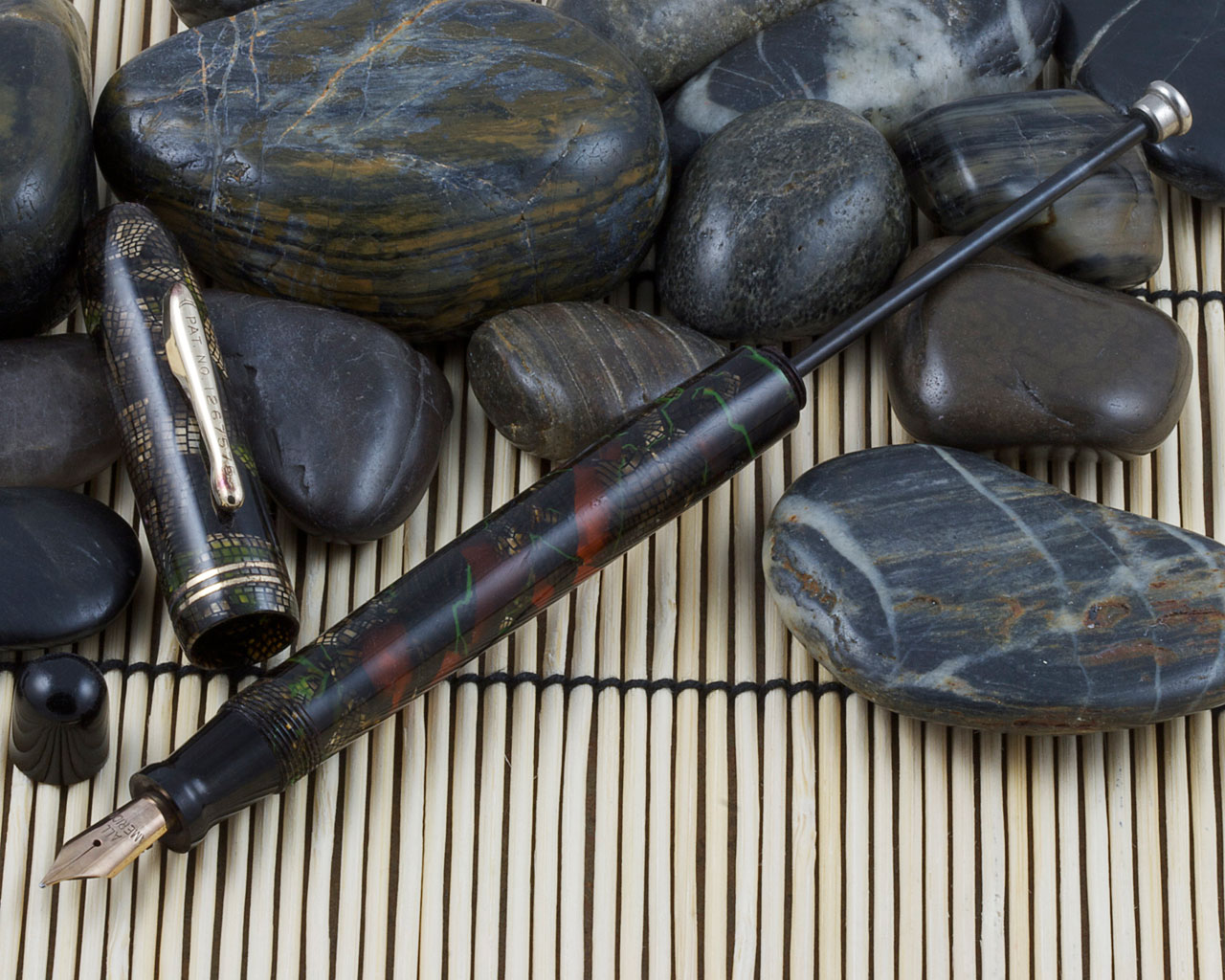 Conklin All American Sacless Vacuum Pen in Reptilian Gold-Green Vein c1937
Conklin All American Sacless Vacuum Pen in Reptilian Gold-Green Vein c1937
The Reptilian skin celluloid used on the Conklin All American Sacless Vacuum Pens makes one of these a stunning centerpiece of a collection. Collector demand and the fact that these pens are fairly uncommon makes them pricey in the market. Although solidly made, examples will commonly suffer from plating loss on the clip and cap bands, and strong ambering to the clear sections of the barrel. Beware of weak springs in the clip and non All American replacement nibs. The original nib may not have been 14 karat gold, but the lack of the correct nib, even if replaced with the higher grade Conklin nibs, devalues the pen.
References
Conklin Catalog 1923, Conklin Pen Company, Toledo, OH, USA
Conklin Catalog 1926, Conklin Pen Company, Toledo, OH, USA
Conklin Catalog 1930-1931, Conklin Pen Company, Toledo, OH, USA
Conklin Dealer Brochure 1932, Conklin Pen Company, Toledo, OH, USA
Conklin Dealer Brochure 1937, Conklin Pen Company, Toledo, OH, USA
Fountain Pens of the World by Andreas Lambrou, © 1995 Zwemmer, London, United Kingdom
"Profile: The Conklin Nozac," Richard Binder, Copyright © 2010, website
Interact
Comments on this article may be sent to the editor, Jim Mamoulides


